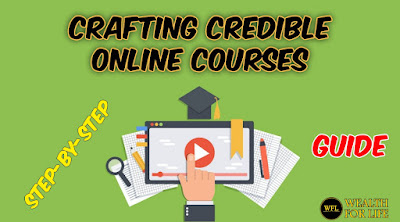Crafting Credible Online Courses: A Step-by-Step Guide
In today's digital age, online courses have emerged as a powerful way to share knowledge, connect with learners worldwide, and even generate income. However, creating a legitimate and valuable online course requires careful planning, expertise, and attention to detail. In this article, we'll walk you through a step-by-step process to build a credible online course that delivers real value to your audience.
1. Identify Your Expertise
Begin by identifying the subject or topic in which you possess deep expertise. Your course should showcase your knowledge, skills, and experiences that align with learners' needs. Whether it's a professional skill, hobby, or academic subject, your expertise is the foundation upon which your online course will be built.
2. Define Clear Learning Objectives
Before you start creating content, define clear and specific learning objectives for your course. What do you want learners to achieve by the end of the course? Break down your objectives into smaller, achievable outcomes. Clear objectives guide your course design and ensure that learners gain tangible skills or knowledge.
3. Choose a Platform
Selecting the right platform to host your online course is crucial. There are various options available, from dedicated course platforms like Udemy, Teachable, and Thinkific to using your own website with learning management system (LMS) plugins. Choose a platform that aligns with your technical expertise, course goals, and budget.
4. Plan Your Course Structure
Organize your course into well-defined sections and modules. Each module should cover a specific topic or concept. Create a logical flow that progresses from foundational concepts to more advanced material. This structure enhances the learning experience and makes navigation intuitive for learners.
5. Create Engaging Content
Develop course content that engages learners and delivers value. Use a variety of formats such as video lectures, text-based lessons, quizzes, assignments, and downloadable resources. Incorporate visuals, real-world examples, and interactive elements to keep learners engaged and facilitate understanding.
6. Record High-Quality Videos
If your course includes video content, invest in recording high-quality videos. Ensure good lighting, clear audio, and a clutter-free background. Use visuals, animations, and slides to enhance the visual appeal of your videos. Well-produced videos contribute to a professional learning experience.
7. Write Compelling Course Materials
For text-based lessons, create well-structured and engaging content. Write in a clear, concise, and approachable manner. Break down complex concepts into digestible chunks and use headings, bullet points, and formatting to make the content visually appealing.
8. Incorporate Interactivity
Engage learners through interactive elements such as quizzes, assignments, discussions, and polls. Interaction fosters active learning and helps learners retain information better. Constructive feedback on assignments or assessments encourages learners' growth.
9. Test and Refine
Before launching your course, test it thoroughly. Enlist a small group of beta testers to provide feedback on content, navigation, and any technical glitches. Use their feedback to make necessary improvements and refinements.
10. Market and Launch
Promote your online course through your network, social media, email marketing, and relevant online communities. Craft compelling course descriptions, use eye-catching visuals, and highlight the benefits of enrolling. Consider offering an introductory discount to attract initial learners.
11. Engage with Learners
Once your course is live, engage with your learners. Respond to questions, participate in discussions, and provide additional insights where relevant. Building a sense of community around your course enhances the learning experience and encourages positive reviews.
12. Continuously Improve
Monitor learner feedback, track completion rates, and gather insights into how your course is performing. Use this data to identify areas for improvement and create updated versions or additional courses that address learners' evolving needs.
In conclusion, creating a legitimate online course is a rewarding endeavor that requires meticulous planning, dedication, and a commitment to delivering value. By leveraging your expertise, crafting engaging content, and providing a comprehensive learning experience, you can build an online course that not only educates but also resonates with your target audience. Remember, the key to success lies in offering actionable knowledge and fostering a positive learning environment that empowers learners to achieve their goals.

